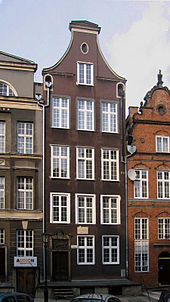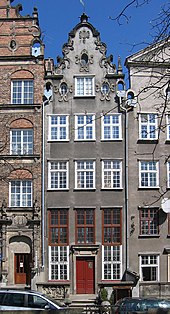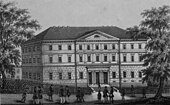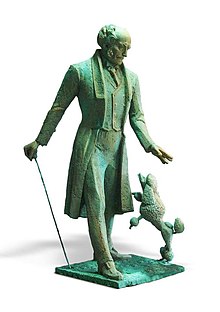List of important residences of Arthur Schopenhauer and his ancestors

This is a list of important places where Arthur Schopenhauer and his ancestors lived . There were accommodations in which the philosopher Arthur Schopenhauer and his family members lived in Gdansk , Hamburg , Weimar , Göttingen , Berlin , Dresden , Munich , Mannheim , Frankfurt am Main and other places.
Most of the houses they lived in no longer exist. The Theaterplatz 1a building in Weimar has been preserved, the birthplace of Johanna and Arthur Schopenhauer in Gdansk have been rebuilt. Arthur Schopenhauer's grave is in Frankfurt am Main. Numerous streets have been named after him and there are a few monuments .
Danzig
Holy Spirit Alley 114
Arthur Schopenhauer was born in 1788 in the residential building at Heilige-Geist-Gasse 114 (today ul. Św. Ducha 47).
The building came into the possession of his father Heinrich Floris Schopenhauer in 1784 at the latest. In 1793 it was sold and the family moved to Hamburg.
At the beginning of the 20th century there was a shoe shop Krefft. In 1944/45 the building was damaged and then rebuilt in a similar form. A plaque commemorates its history.
Holy Spirit Alley 81
Johanna Trosiener , the mother of Arthur Schopenhauer, was born in the residential building at Heilige-Geist-Gasse 81 (today ul. Św. Ducha 111) .
The turtle house , so named because of a turtle in the gable, was also damaged in 1944/45 and then rebuilt. Today there is a library with an event area.
Hamburg
New way 76
In 1793 the family moved into the house in the old town of Neuerweg 76.
The street was demolished around 1890.
New wall frame 92
In 1796 the family bought a larger house at 92 Neuer Wandrahm , which was a popular residential area with merchants. There were also the business and storage rooms, at the back a canal ( fleet ) flowed for the movement of goods. In 1797 their daughter Adele was born here.
The married couple Heinrich and Johanna Schopenhauer frequented the most prestigious circles in Hamburg, they had good contacts to the wholesale merchant Georg Heinrich Sieveking , the scholar Johann Albert Heinrich Reimarus , the poet Friedrich Gottlieb Klopstock , the painter Wilhelm Tischbein and others.
Young Arthur was taken several times on long trips abroad. From 1799 he attended the private school of Dr. Runge in Hamburg. In 1805 he began an apprenticeship as a businessman with Senator Martin Jenisch . That year, the father Heinrich Floris Schopenhauer had an accident at the house, probably by suicide. The mother then sold the building.
At the end of the 19th century the street was demolished for the construction of the Speicherstadt.
Bailey 87
In 1805 the family moved into an apartment in Kohlhöfen 87 (later No. 29). There, the mother Johanna prepared the move for herself and the daughter Adele to Weimar , which took place in 1806.
The house was replaced by a new building around 1890.
House Willink
The 18-year-old Arthur stayed in Hamburg and continued his business apprenticeship. During this time he lived with the accuracy broker Gysbert Willink, a former business partner of his father.
In April 1807 he finally received permission from his mother to break off his apprenticeship and begin a career in science. For this he first moved to Gotha .
Le Havre
From 1797 the 9-year-old Arthur Schopenhauer lived in Le Havre in France with Grégoire de Blésimaire, a business friend of his father, and his son Anthim. There he improved his language skills and was made familiar with the culture and literature ( Voltaire ) of the country. Later he once wrote that these were the best years of his childhood. In 1799 he returned to Hamburg .
Gotha
From June to December 1807 Arthur Schopenhauer attended the Illustre grammar school in Gotha . He stayed with the philology professor Karl Gotthold Lenz as a pension.
Because of a mocking poem, he had to leave the city in December and moved to Weimar.
Weimar
Arthur Schopenhauer's apartment
From December 1807 Arthur Schopenhauer lived in a small apartment in Weimar. From there he regularly visited his mother, who had previously insisted that he live separately from her.
He attended high school and began an intensive intellectual exchange with the successful author Zacharias Werner . At the beginning of 1809 he received his share of the paternal inheritance after reaching the age of majority. Schopenhauer finished high school and went to Göttingen to study .
Schillerstrasse 10
From 1806 Johanna Schopenhauer lived with her daughter Adele in a rear building on Windischenstraße, which had the postal address Schillerstraße 10.
There she soon met Johann Wolfgang von Goethe , with whom she had been in regular contact ever since. She was the first to receive his newly married wife Christiane Vulpius , who until then had been shunned by society because of her lower class.
Johanna Schopenhauer set up a literary salon, which became the first social meeting place for the Weimar people outside the court. These included the art critic Carl Ludwig Fernow , the publisher Friedrich Justin Bertuch and his son Carl , Friedrich Wilhelm Riemer , the painter Heinrich Meyer , the poet Christoph Martin Wieland and others. In the spring of 1811 the son Arthur Schopenhauer had an encounter with him during his visit to Weimar during the Easter holidays. External guests in the salon were the writer Bettina von Arnim , the philosophers August Wilhelm and Friedrich Schlegel , Hermann Pückler-Muskau , the writer Zacharias Werner and others.
In 1813 Johanna and Adele Schopenhauer changed their apartment within Weimar.
The house was demolished in 1896. Since 2017 a plaque commemorates the well-known former resident.
Theaterplatz 1 a
From 1813 Johanna Schopenhauer lived at Theaterplatz 1 a, an extension to a Baroque building from 1784 near the theater. Daughter Adele and friend Georg Friedrich von Gerstenbergk also lived there . Johanna Schopenhauer continued her salon there.
In the spring of 1813 her son Arthur lived with her for a short time and then moved to Rudolstadt . He returned in November and had several encounters with Goethe. The orientalist Friedrich Majer made him familiar with ancient Indian philosophy. In May 1814 the son fell out completely with his mother and went to Dresden . In 1819 he returned to Weimar shortly after the bankruptcy of the Muhl bank.
Johanna Schopenhauer and their daughter Adele moved to Unkel and Bonn on the Rhine in 1829.
The building is preserved. Today there is a restaurant ( theater café ).
Goettingen
In 1809 Arthur Schopenhauer came to Göttingen to study . He lived there in a small furnished apartment. Schopenhauer mainly listened to scientific lectures in a wide variety of disciplines and finally came to the philosopher Gottlob Ernst Schulze , who introduced him to Immanuel Kant and Plato and ultimately showed him his further philosophical path.
In 1811 Schopenhauer moved to the new university in Berlin .
Berlin
1811 to 1813
From 1811 Arthur Schopenhauer studied in Berlin at the newly opened Humboldt University . He heard lectures by Johann Gottlieb Fichte and Friedrich Schleiermacher , and his admiration for them turned into contempt. On the other hand, he valued the classical philologist Friedrich August Wolf , at whom he heard several events on ancient Greek literature and who supported him.
In the spring of 1813 Schopenhauer left the city because of the threat of war and went back to his mother in Weimar .
1820 to 1822
In March 1820 Schopenhauer came back to Berlin and gave his inaugural lecture there at the university. He deliberately put his subsequent regular events at the same time as Hegel's, which led to low audience numbers.
Last street 34
From mid-March 1820 Arthur Schopenhauer lived in a small, furnished apartment at Letzt Strasse 34 (today Dorotheenstrasse 83).
The historic house no longer exists.
Kronenstrasse 55
After that he lived briefly at Kronenstrasse 55.
The house no longer exists.
Niederlagwallstrasse 4
From May or October 1820 Arthur Schopenhauer lived in two rooms at Niederlagwallstrasse 4 (later Niederlagstrasse 4.). There, on August 12, 1821, he threw the roommate Marquet out of the entrance hall, where she had been talking loudly with two maids. Since she had allegedly had a tremor in her arm since then, he was sentenced to pain and suffering and life alimony after long trials.
In 1822 Schopenhauer began a trip to Italy.
The house no longer exists.
1825 to 1831
From April 1825, Schopenhauer lived again in Berlin and continued his university career.
Leipziger Strasse 78
He lived (1822 or 1825?) In an apartment at Leipziger Strasse 78.
The house no longer exists.
Behrenstrasse 70
The address Behrenstrasse 70 is known from November 24, 1828 and May 15, 1829 .
Mathilde Rohr opened a literary salon in the house in 1833, which Theodor Fontane visited in 1852 . The house then became the property of the Ministry of Culture and was replaced by a new building around 1890. This was destroyed around 1944/45.
Dorotheenstrasse 30
Schopenhauer probably lived at Dorotheenstrasse 30 (today No. 90) from 1829 to 1830 .
The building was replaced by a new one around 1890.
French street 17
The last apartment in Berlin was at Französische Strasse 17.
From there Schopenhauer moved to Frankfurt am Main in 1831 because of the impending cholera epidemic .
Rudolstadt
In June 1813, Schopenhauer took up residence at the “Zum Ritter” inn in Rudolstadt , one of the most modern inns in Thuringia at the time. There he found peace from the chaos of war in the area. Schopenhauer wrote his dissertation on the fourfold root of the principle of sufficient reason . He enjoyed the surroundings on long walks.
He left the words Arth on a window in his room on the second floor . Schopenhauer majorem anni 1813 partem in hoc conclave degit. Laudaturque domus, longos quae prospicit agros. [Arthur Schopenhauer spent most of 1813 in this conclave. Praise be to the house that looks out over wide fields] , which a guest discovered forty years later.
In October he submitted the thesis to the University of Jena and returned to Weimar in November .
The “Zum Ritter” inn was demolished in 2003.
Dresden
First short stays
In 1804, the 16-year-old Arthur Schopenhauer first visited the Elbe city of Dresden on his return journey from France with his parents. In May 1813 he stayed here a few days after his escape from Berlin and then drove on to Weimar .
1814 to 1818
Grosse Meißniche Gasse 35
From April 1814 Arthur Schopenhauer lived in Dresden. He lived in the house of the philosopher Karl Christian Friedrich Krause at Grosse Meißnische Gasse 35 III (later Kaiser-Wilhelm-Platz 6) in the Neustadt. The house was in the immediate vicinity of the Japanese Palace , which, among other things, housed the Asian section of the electoral library (with the Indian cabinet ), which Schopenhauer frequently used.
He was in contact with literary circles around the then well-known authors Friedrich Gustav Schilling , Carl Heun and Friedrich August Schulze . Schopenhauer attended their events, but avoided more intensive relationships.
In 1816 he published the book About Sehn to his own color theory.
The house was destroyed in 1945.
Ostra avenue 897
Around 1816 Schopenhauer moved into a garden house at Ostra-Allee 897 (later different numbering), which was in a quiet and charming landscape. The postal address remained Grosse Meißniche Gasse, where he may still be staying temporarily.
It was there that Arthur Schopenhauer completed a large part of his major work Die Welt als Wille und Concept , which he published in 1818. He had intensive discussions with Karl Christian Friedrich Krause .
In 1818 Schopenhauer went on a trip to Italy , from which he briefly returned the following year to Ostra-Allee and then moved on to Weimar and Berlin .
1824 to 1825
From September 1824 to May 1825 Schopenhauer lived again in Dresden. In May of the following year he moved back to Berlin .
Italy
1818 to 1819
In the autumn of 1818 Arthur Schopenhauer traveled to Italy . In Venice he met Teresa Fuga. Further stations were Bologna , Florence and Rome , where he spent the winter, then Paestum , Naples and finally Milan . There he received the news of the collapse of the trading house AL Muhl & Co. in June , which prompted him to return to Dresden and Weimar immediately .
1822 to 1823
In the autumn of 1822 Schopenhauer traveled again to Italy. He visited Milan, Venice and Florence and moved to Munich in 1823.
Munich
In June 1823 Arthur Schopenhauer moved to Munich . There he suffered from depression and physical ailments, and his right ear became almost completely deaf. At that time he had almost no contacts in the city. In 1824 he went to Wildbad (today Bad Gastein) for a cure .
In June of the same year he visited various cities (Mannheim) and in September moved again to the beloved Dresden .
Mannheim
From July 1833 Arthur Schopenhauer lived in Mannheim . One apartment was at address C2.9 . He often visited the Harmonious Society and other cultural events and bought a new poodle .
In June 1833 he decided to move back to Frankfurt.
Frankfurt am Main
1831 to 1832
Old Schlesingergasse
At the end of August 1831, Schopenhauer moved to Frankfurt am Main because of the cholera epidemic that had broken out in Berlin , which was considered cholera-safe . At first he lived in Alte Schlesingergasse , house number probably no. 16/18. In winter he experienced several months of severe depression and decided to move to Mannheim .
1833 to 1860
From June 1833, Schopenhauer lived again in the old apartment on Alte Schlesingergasse.
“Healthy climate. Pretty environment. Amenities of big cities. Change of big cities. Better reading room. The Natural History Museum. Better acting, opera, and concerts. More English. Better coffee houses. Not bad water. The Senckenberg Library. No flooding. Less observed. The friendliness of the place and all of its surroundings. You are more unrestricted and less bothered with company that chance, not your choice, gives you, and you have the freedom to cut off and avoid unpopular company. A skilled dentist and less bad doctors. Not so unbearable heat in summer. The physical cabinet. "
he had noted for himself as reasons.
Here he wrote On the Will in Nature . Arthur Schopenhauer avoided intensive personal contacts during this time and was often on long walks with his poodle.
The street and the surrounding area were destroyed in the air raids in 1944 and never rebuilt. From 1969 to 1971 the 93 meter high Deutsche Bank IBCF was built on the site . It was demolished in 2018 for the new Four high-rise quarter .
Saalgasse 23
After that he may have lived at Saalgasse 23 for a while .
At the cutting wall 10
In 1836 Schopenhauer moved to the house at Am Schneidwall 10 (later Untermainkai 2). There he wrote the book On Freedom of the Human Will , which was awarded in Oslo in 1839 .
In 1838 he wrote about his fellow citizens: For the people of Frankfurt, Frankfurt is the world. It's a small, stiff, inwardly raw, municipal-inflated, peasant-proud Abderite nation that I don't like to approach.
Neue Mainzer Strasse 10
In April 1840 Arthur Schopenhauer set up an apartment with his own furniture for the first time at Neue Mainzer Straße 10. During this time he finished the second part of his major work The World as Will and Idea .
Nice view 17
On March 1, 1843, Schopenhauer moved into a rented apartment on the ground floor in the classicist building Schöne Aussicht 17 , on the corner of Fahrgasse . There the font Parerga and Paralipomena originated , which in 1851 developed into his only bestseller during his lifetime.
He became a celebrity in the city, but without honors and official recognition, as he remained very harsh in personal dealings and repelled many fellow citizens.
Nevertheless, a small circle of followers ( disciples ) had gathered, with whom he maintained more intensive contacts. These included Julius Frauenländer , the author Georg Römer and Wilhelm Gwinner , who later became his executor and first biographer.
In the summer of 1859 there was a dispute with his landlord about the Butz ( Atman ) poodle and Arthur Schopenhauer moved into the neighboring house.
The house was named Schopenhauerhaus in the address book in 1916 , but was destroyed in 1944.
Nice view 16
In the summer of 1859 Arthur Schopenhauer moved into the neighboring house with his housekeeper Margarethe Schnepper and the poodle: You know, I now live in Wertheimber's house No. 16, ground floor, right, glass door, ring hard.
The neighbor Lucia Franz-Schneider wrote detailed descriptions of his everyday life and his habits there.
Arthur Schopenhauer died on September 21, 1860 on the sofa in his apartment.
The house, built in 1805 by city architect Johann Georg Christian Hess for the banker Wolf Zacharias Wertheimber , was considered a major work of bourgeois classicism in Frankfurt. After Schopenhauer's death, other Frankfurt scholars lived here, including Tycho Mommsen , Johannes Janssen and the architect Ernst Hiller . After the art historian Fried Lübbecke moved in in 1917, the name Schopenhauerhaus , which was previously more associated with the neighboring house , probably slowly gained acceptance. Both buildings were destroyed in the air raid on March 22, 1944 and never rebuilt.
Memorials
Memorial and research sites
There is currently no museum about Arthur Schopenhauer, nor about his mother Johanna Schopenhauer.
- Schopenhauer Archive Center , at the University Library in Frankfurt, with an estate
- Schopenhauer Research Center , at the Philosophical Seminar of the University of Mainz
Monuments and sculptures
- Bust of Arthur Schopenhauer, 1859, Elisabeth Ney, marble, based on a living model
- Bust of Arthur Schopenhauer, 1895, Friedrich Schierholz, bronze, Frankfurt am Main, 1952 restored
- Sculpture Arthur Schopenhauer, 2008, Bolesław Marschall, Gdansk, Ronald Reagan Park
- Arthur Schopenhauer with poodle, 2014, Giennadij Jerszow, bronze, Danzig
literature
- Walther Rauschenberger : Schopenhauer's apartments during his life. In: Yearbook of the Schopenhauer Society . 25. 1938. pp. 281-293, with 16 illustrations
- Walther Rauschenberger: Schopenhauer's apartments. An addendum. In: Yearbook of the Schopenhauer Society. 1939. pp. 385-388.
- Wilhelm Gwinner : Arthur Schopenhauer presented from personal dealings. Brockhaus, Leipzig 1862 digitized
- Wilhelm Gwinner: Schopenhauer's life. Second, revised and often enlarged edition. Brockhaus, Leipzig 1878 digitized
- Johanna Schopenhauer : Youth life and hiking pictures. Estate. Braunschweig 1839, autobiography
- David E. Cardwright: Schopenhauer. A biography. Cambridge University Press, 2010, detailed biography
Web links
Individual evidence
- ↑ Schopenhauer House in Danzig Forum Danzig
- ^ Arthur Huebscher: Youth in Hamburg . In: Schopenhauer yearbook. 51. 1970. S. 3-21, here p 3, here as Neuer Weg 76 specified
- ↑ The world is my will by Thomas Andre, Hamburger Abendblatt from September 21, 2010
- ↑ Arthur Hübscher, Jugendjahre in Hamburg , S. 3f., After Johanna Schopenhauer Jugendleben and Wanderbilder. Volume 2. Braunschweig 1839, fragments of the autobiography from the estate
- ^ Arthur Huebscher: Youth in Hamburg. In: Schopenhauer yearbook. 51, 1970. pp. 3-21, here p. 12
- ↑ Arthur Hübscher, Jugendjahre , p. 6
- ^ Roland Krischke: Schopenhauer in Gotha. Mitteldeutscher Verlag, Halle 2013; also Schopenhauer in Gotha by Roland Krischke, in Thüringische Landeszeitung of March 23, 2013, p. 4
- ↑ Schopenhauer in Gotha and Weimar by Roland Krischke, Goethe Society Erfurt
- ^ Annette Seemann: Goethe's Places in Weimar. Suhrkamp, 2019, p. 127
- ^ Letter from Johanna Schopenhauer to Arthur Schopenhauer dated October 24, 1806
- ↑ Johanna Schopenhauer zeno.org, biography
- ^ Rolf Haage: Weimar. A guide through the classic city. Erfurt 2011, ISBN 978-3-86680-829-4 . P. 126 f.
- ^ Rudolf Borch: To the Berlin apartments. In the yearbook of the Schopenhauer Society. Volume 29. 1942, p. 231 ff.
- ^ Karl Voss: Berlin, travel guide for literature lovers, from Alex to the Kudamm , Berlin 1986, ISBN 3-548-04069-1 , pp. 56, 64, 65, 80, 85, 108, 119, on the various apartments in Berlin
- ^ Karlheinz Muscheler: The Schopenhauer-Marquet trials and Prussian law. Mohr Siebeck, Tübingen 1996, p. 4 , note, he assumes May, Schopenhauer had specified October ( for 10 months ).
- ↑ Ludger Lütkehaus: The book as will and idea. Schopenhauer's correspondence with Friedrich Arnold Brockhaus. Berlin 1996, pp. 44 , 47
- ^ Address book Berlin , 1829 (?)
- ^ Wilhelm Gwinner : Schopenhauer's life. Second, revised and often enlarged edition. Brockhaus, Leipzig 1878. p. 109 digitized version (152) , containing a quotation from Horace
- ^ Robert L. Wicks: The Oxford Handbook of Schopenhauer. Oxford 2020. pp. 30–44, especially pp. 32 and 44. Krause taught in Berlin from 1813 to 1815.
- ↑ Walther Rauschenberger: Schopenhauer's apartments during his life. In: Yearbook of the Schopenhauer Society. 25. 1938, pp. 281-293, here p. 286
- ^ Walther Rauschenberger: Schopenhauer's apartments. An addendum. In: Yearbook of the Schopenhauer Society. 26. 1939. pp. 385-388, here p. 387
- ↑ Gastein in Pictures - History / Gastein's Spa Guests , accessed on August 13, 2020
- ↑ Hanspeter Rings: The "invisible brain shell" - Arthur Schopenhauer in Mannheim. In: Mannheim history sheets . 25. 2013. pp. 49–66 describes this period of Schopenhauer's life in Mannheim most knowledgeably.
- ↑ During the Frankfurt time, basically Wolfgang Klötzer (Hrsg.): Frankfurter Biographie . Personal history lexicon . Second volume. M – Z (= publications of the Frankfurt Historical Commission . Volume XIX , no. 2 ). Waldemar Kramer, Frankfurt am Main 1996, ISBN 3-7829-0459-1 . , Pp. 329–334, then Inge Kaltwasser : Schopenhauer, Arthur in the Frankfurter Personenlexikon (as of October 30, 2019) Query date: May 23, 2020.
- ↑ Klötzer 1996, p. 329 gives house number 32. But since there were only 20 houses in Alte Schlesinger Gasse at that time, the number E32 could have been meant, which is now 16/18, cf. Schopenhauerhaus , note 48
- ↑ Inge Kaltwasser : Schopenhauer, Arthur in the Frankfurter Personenlexikon (article as of October 30, 2019). Query date: May 23, 2020. Also in: Wolfgang Klötzer (Ed.): Frankfurter Biographie . Personal history lexicon . Second volume. M – Z (= publications of the Frankfurt Historical Commission . Volume XIX , no. 2 ). Waldemar Kramer, Frankfurt am Main 1996, ISBN 3-7829-0459-1 , p. 329-334 .
- ↑ Letter quote in Schemann 1893, p 406
- ↑ Lucia Franz-Schneider: Memories of the Schopenhauerhaus Schöne Aussicht No. 16 in Frankfurt am Main. Written down by Lucia Franz-Schneider in 1911. With an afterword by Fried Lübbecke. 2nd Edition. Waldemar Kramer Verlag, Frankfurt am Main 1987, ISBN 3-7829-0347-1 .
- ^ Archive Center Schopenhauer Society
- ↑ Schopenhauer Monument Frankfurt Art in Public Space










